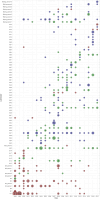The value of the continuous genotyping of multi-drug resistant tuberculosis over 20 years in Spain
- PMID: 33235225
- PMCID: PMC7686341
- DOI: 10.1038/s41598-020-77249-x
The value of the continuous genotyping of multi-drug resistant tuberculosis over 20 years in Spain
Erratum in
-
Author Correction: The value of the continuous genotyping of multi-drug resistant tuberculosis over 20 years in Spain.Sci Rep. 2025 Mar 13;15(1):8730. doi: 10.1038/s41598-025-90681-1. Sci Rep. 2025. PMID: 40082475 Free PMC article. No abstract available.
Abstract
Molecular epidemiology of circulating clinical isolates is crucial to improve prevention strategies. The Spanish Working Group on multidrug resistant tuberculosis (MDR-TB) is a network that monitors the MDR-TB isolates in Spain since 1998. The aim of this study was to present the study of the MDR-TB and extensively drug-resistant tuberculosis (XDR-TB) patterns in Spain using the different recommended genotyping methods over time by a national coordinated system. Based on the proposed genotyping methods in the European Union until 2018, the preservation of one method, MIRU-VNTR, applied to selected clustered strains permitted to maintain our study open for 20 years. The distribution of demographic, clinical and epidemiological characteristics of clustered and non-clustered cases of MDR/XDR tuberculosis with proportion differences as assessed by Pearson's chi-squared or Fisher's exact test was compared. The differences in the quantitative variables using the Student's-t test and the Mann-Whitney U test were evaluated. The results obtained showed a total of 48.4% of the cases grouped in 77 clusters. Younger age groups, having a known TB case contact (10.2% vs 4.7%) and XDR-TB (16.5% vs 1.8%) were significantly associated with clustering. The largest cluster corresponded to a Mycobacterium bovis strain mainly spread during the nineties. A total of 68.4% of the clusters detected were distributed among the different Spanish regions and six clusters involving 104 cases were grouped in 17 and 18 years. Comparison of the genotypes obtained with those European genotypes included in The European Surveillance System (TESSy) showed that 87 cases had become part of 20 European clusters. The continuity of MDR strain genotyping in time has offered a widespread picture of the situation that allows better management of this public health problem. It also shows the advantage of maintaining one genotyping method over time, which allowed the comparison between ancient, present and future samples.
Conflict of interest statement
The authors declare no competing interests.
Figures





References
-
- Dheda, K. et al. The Lancet Respiratory Medicine Commission: 2019 update: epidemiology, pathogenesis, transmission, diagnosis, and management of multidrug-resistant and incurable tuberculosis. Lancet Respir. Med.7, 820–826 (2019). - PubMed
-
- European Centre for Disease Prevention and Control. ECDC strategic framework for the integration of molecular and genomic typing into European surveillance and multi-country outbreak investigations: 2019–2021 (ECDC, Stockholm, 2019).
-
- Samper, S., Iglesias, M. J. & Tello, O. The Spanish multidrug resistant tuberculosis network. Euro Surveill.5, 37 (2000). - PubMed
-
- Gavin, P. et al. Long-term molecular surveillance of multidrug-resistant tuberculosis in Spain. Infect. Genet. Evol.12, 701–710 (2012). - PubMed
Publication types
MeSH terms
LinkOut - more resources
Full Text Sources

